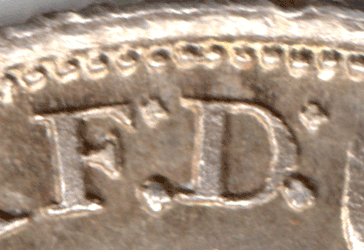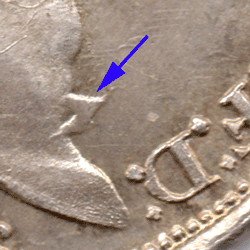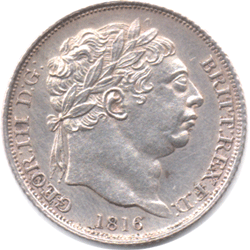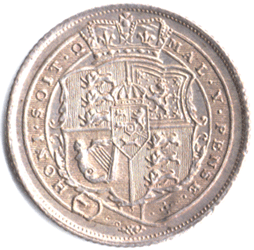|
Michael Coins Ltd |
![]() Other Lists
Other Lists
COIN CLUB
1816 Sixpences struck from Un-adopted 'Trial dies' !?
|
|
|
|
|
SX 1816 X |
SX1816 X |
This Obverse will be referred to as Obverse X.
The legend has the following punctuation stops:
| Diamond (or lozenge) stops after GEOR: (♦) |
| Square stops after D: G: (■) |
| Square to slightly Diamond stops after BRITT: (■ /♦) |
|
Diamond (or lozenge) stops after F: D: (♦) |
I first listed this coin, in 2018, and listed it as "A possible unique example" of legend
stops for an 1816 Sixpence.
However, in June 2020 thanks to M.R. a second example of Diamonds and Square stops
on an 1816 Sixpence has appeared and in this article is referred to as Obverse Y.
As previously mentioned "Every other 1816 Sixpence I have examined over the years
(and there have been quite a few !) have ALL had circular stops in the legend !
In fact ALL other sixpence from 1816 onwards have always had circular colon dot stops.

|
|
SX 1816 Y |
This Obverse will be referred to as Obverse Y.
The legend has the following punctuation stops:
| Diamond (or lozenge) stops after GEOR: (■) |
| Square stops after D: G: (♦) |
| Diamond stops after BRITT: (♦) |
|
Diamond (or lozenge) stops after F: D: (■) |
Obverse Y also has Diamonds and Square stops but in a different
configuration to Obverse X !? In fact, mirror image opposites !
 |
|
|
SX 1816 X (GEOR ♦ III) |
 |
|
| SX 1816 Y (GEOR ■ III) |
 |
 |
|
| SX 1816 X (D ■ G ■) | SX 1816 Y (D ♦ G ♦) |
 |
|
| SX 1816 X (BRITT ■ /♦) |
 |
|
| SX 1816 X (BRITT ♦) |
 |
 |
|
| SX 1816 X (F ♦ D ♦ ) | SX 1816 Y (F ■ D ■ ) |
 |
|
| SX 1816 X |
SX 1816 X also has a strange 'extra' bit to the front of George's throat.
As far as I can tell this is not due to a part of the reverse showing through from a clashed die.
I am unable to explain how it occurred.
~~~~~~~~~~~~~~~~~
There now appears to be at least TWO 1816 Sixpences with obverse legends that have
completely unusual colon stops (Diamonds ♦ & Squares ■) to the 'normal' circular ● stops.
These TWO different obverse dies however are completely different in that they are mirror
opposites. Where one has Diamond ♦ colon stops the other has Square ■ colon stops.
Or visa versa !
Is it possible that there could be other obverse dies with a different Diamond ♦ & Square ■
colon stops combination ?
Is there a 1816 Sixpence obverse die that has FULL Diamond ♦ colon stops or one with
FULL Square ■ colon stops ? Until an example like that turns up we will never know !
Unfortunately there probably are no Royal Mint records showing why these obverse dies
were made. So we have to make up our own minds as to why they might have occurred.
Were these two coins struck from obverse "trial dies" to see if Diamond ♦ or Square ■ colon
stops could or would be acceptable instead of the normal or regular - circular colon dots stops !?
This was the start of a new era with the re-coinage of our entire currency. New portraits,
new legends and punctuation would have been the order of the day.
So are these two coins evidence from some of those early "trial dies" !?
It is obvious that Diamond ♦ or Square ■ colon stops proved to be unacceptable and that the
traditional circular colon dots was deemed to be best suited and have carried through up to today.
Now what could possibly have happened to these "un-adopted trial dies" ?
It is possible that these "trial dies" were put aside, possibly to be destroyed at a later stage,
but due to the pressures of minting large quantities of new coins these two obverse dies were
picked up and inadvertently used. They would have appeared to be fresh nearly new dies that
had had very little use and could therefore be used to strike many more 'currency' coins.
This sort of 'accident' of the use of "un-adopted trial dies" is not unknown as is the case of
the Victorian 1847 copper penny and of TWO 1860 beaded border bronze pennies which were
used to strike some currency issue coins.
The idea of using 'stops' other than circular 'dots' for the punctuation of the coin's legend in not
new. One only has to go back to the reign of Henry VI (1422 to 1461) to see that different stops
were used as punctuation. Such as, Annulet (1422 to 1430). Annulet-trefoil (142? to 1433?).
Rosette-mascle issue (1430 to 1431). Pinecone-mascle (1431 to 1433).
Leaf-mascle (1432 to 1436), Leaf-trefoil (1436 to 1438).Trefoil (1438 to 1443). etc.
A bit of History
1816 is a common date for sixpences due to the large amount made for the ‘new’ re-coinage era.
There is no official mintage figures for 1816 coins. These new coins were being made round the
clock from mid-August to February 1817 in readiness for distribution. Records however do show
that by year’s end (1816) approximately £2,000,000 (2 million pounds) of face value coins had
been struck. Approximately, 11 million of those coins were sixpences.
The new coinage was made legal tender and first became available on 17th February 1817.
On 1 March 1817 all previous silver coinage was demonetised and three months grace was given
for the old coinage to be exchanged.
It is amazing that in just over 200 years no one else has spotted these 'experimental' colon
stop differences on the 1816 Sixpences.
Now that it has been brought it to the attention of collectors, that look on my website, I am
sure that several more examples of these ‘Diamond ♦ or Square ■’ colon stops Sixpences
will be found.
On Ebay there is always a large amount of 1816 Sixpences for sale and it appears from
some of the pictures of 1816 Sixpences that there could be several examples being offered
'unknowingly' for sale with 'Diamond ♦ & Square ■' colon stops.
As to whether this new variety is extremely rare or not - only time will tell as hopefully
more 1816 Sixpences with the 'Diamond ♦ or Square ■' colon stops come to light.
These two special 1816 Sixpences highlight the interesting times and thought that went
on in the minds of those working in the Royal Mint to see if breaking with conventional
circular stops for colon 'dots' was acceptable, feasible or practical !
| Back to Sixpences |

